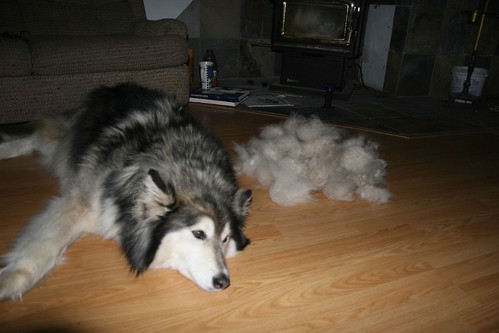 |
| Photo by Jon (Click to see original on Flickr) |
Spring Shedding Season is arriving in the southeast and will be coming to a location near you over the next few months! Longer days combined with warmer weather will trigger many pets to start shedding their dense winter coats. Shedding can be particularly severe for some pets, particularly those with thick or double coats, such as shepherds. If you happen to have a Poodle or Mexican Hairless, you will fly through this season without so much as a patch of fur in the road. However, if you have a pet who sheds, this article is for you!
If your pets are anything like mine, you may find yourself reaching for your vacuum and pet hair roller frequently over the upcoming months. I know spring is right around the corner when my lab starts forming little hair tufts in her coat and when I can't seem to run the vacuum often enough to keep up with the hair. I had one client tell me this morning that her dog actually enjoys having the vacuum attachment run loving over his coat to grab that loose fur! While I don't recommend this as a method for you to personally employ on your canine or feline companion, I do have a few helpful tips for you that might make shedding a little more bearable.
1.) You are what you eat: For healthy skin and coat, make sure to feed your pet an excellent quality dog food. Avoid foods with artificial colors and preservatives and by-products. Supplements and diets with omega 3 fatty acids can help promote healthy skin and coats.
2.) For dogs, regular shampooing with a mild oatmeal shampoo or a prescription shampoo (for pets with skin conditions) can help remove loose hair and keep your pet smelling clean and fresh.
3.) Regular brushing will help remove loose hair. The type of brush you choose will depend on your particular pet's coat. Your pet may need a slicker, shedding brush, or a comb to work through mats. Personally, I really love the Furminator for my lab and cats. It is not for breeds with continuous-growing coats, like poodles, and you do need to use it carefully because some pets have very sensitive haircoats and skin, it can be very effective if used properly. I'm always surprised by the amounts of fur that I remove from my pets, but even my cats seem to enjoy the gentle brushings!
4.) Pets with a heavy undercoat or matting may require seasonal grooming to remove mats or to shave the coat.
5.) Lastly, if your pet seems itchy, has fleas or other external parasites such as ticks, or has dander, red spots, or patchy hair loss where you can see the skin, please schedule an appointment with your veterinarian. Hair loss, or poor hair regrowth after shaving, may be due to an underlying medical condition and not due to seasonal shedding.
Unfortunately, there is no magic product or supplement that will end shedding, and be suspicious or products that claim to do so. Perhaps one day we will have a magic cure to end or at least slow the daily hair loss of our furry friends. I often think to myself that the person who comes up with a "cure" for shedding will not only become the richest person in the world but will also enjoy unending appreciation and accolades from pet lovers both near and far.
Written by Dr. Laura Devlin Bacon
Laura Devlin Bacon, DVM DABVP
Lap of Love Veterinary Hospice
Knoxville, Tennessee
drlaura@lapoflove.com
www.lapoflove.com
Dr. Bacon services the Greater Knoxville Area, including Farragut, Lenoir City, Oak Ridge, Clinton, Luttrell, Maryville, Sevierville, and Dandridge.






















